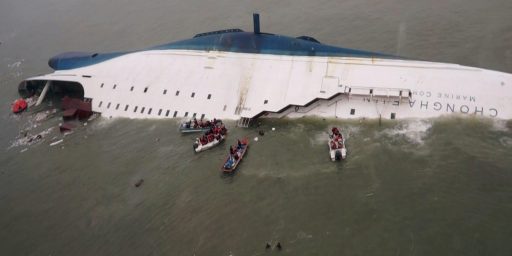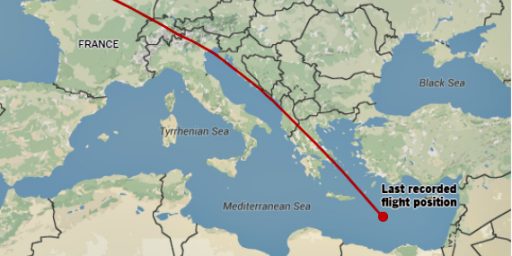Egyptian Passenger Ship Sinks in Red Sea
An Egyptian ship carrying 1300 passengers has sunk. There are survivors but the number is not yet known.
An Egyptian passenger ship carrying 1,300 people has sunk in the Red Sea, the head of the Egyptian Maritime Authority, Mahfouz Taha Marzouk, said Friday. The ship, “Salaam 98,” sunk 40 miles off the Egyptian port of Hurghada, Marzouk said.
Helicopters have spotted bodies as well as one lifeboat carrying three people in the vicinity of where the 25-year-old ship was last seen on the radar screens, Egyptian maritime officials said. They did not say how many bodies were sighted.
Four Egyptian frigates have sailed to rescue survivors, Egypt’s minister of transport, Mohammed Lutfy Mansour, told CNN shortly before the sinking of the ship was announced. “The Coast Guard is doing every in its power to try to rescue these people,” Mansour said.
CNN reports that it was likely carrying returning hajj pilgrims and workers returning home from Saudi Arabia.
CNN’s Ben Wedeman said that it is the end of the mid-term break in Egyptian schools and some of those aboard were likely to be families of Egyptian workers living in Saudi Arabia returning at the end of the break. Others would be Egyptians returning to Egypt after taking part in the hajj pilgrimage to Mecca, he added. He said there was a record of fatal accidents in that part of the Red Sea. He said that in 1991 more than 500 people were killed when a ferry hit a coral reef outside the same Egyptian port.
David Osler, of Lloyd’s List, told CNN while it was too early to speculate on the cause of the ship’s disappearance, the vessel was a roll-on roll-off ferry — a design known to suffer stability problems. “Once a small amount of water gets on board it can set up an uncontrollable rocking that causes rapid capsize,” he said. He said safety standards in the developed world had improved markedly in the after the Pride of Free Enterprise sank at Zeebruge, Belgium, in 1987, killing 193 passengers. “This vessel was pensioned off from Italy. It may have been overloaded,” he said.
Lovely.
Update (0756): So far, 15 bodies have been recovered along with “at least 12 survivors.” Let’s hope the first count is final.
Update (0939): “Coast Guard vessels pulled dozens of bodies from the water Friday and rescued 100 survivors.”
Update (1615): “Coast Guard vessels pulled some 185 bodies from the sea, and at least 263 survivors escaped on lifeboats, officials said.” (AP)
Update (2208): Most of 1,400 on Doomed Ferry Feared Lost (AP)
An aging ferry sank in the choppy waters of the Red Sea on Friday with more than 1,400 people on board, mainly Egyptian workers returning from Saudi Arabia. Most were feared lost, but at least 324 apparently made it to safety.
Passengers said fire broke out on board the ship early in its trip. Transportation Minister Mohammed Lutfy Mansour told reporters early Saturday that the fire was “small” and that investigators were working to determine whether it was linked to the sinking. He said there was no explosion on the vessel.
At the Egyptian port of Hurghada, nearly 140 survivors arrived early Saturday — the first significant group to come to shore. They walked off the ship down a ramp, some of them barefoot and shivering, wrapped in blankets, and immediately boarded buses to take them to the hospital.
Many said the fire began between 90 minutes and 2 1/2 hours after the ship’s departure, but that it kept going and the fire burned for hours. “The fire happened about an hour or 90 minutes into the trip, but they decided to keep going. It’s negligence,” one survivor, Nabil Zikry, said before he was moved along by police, who tried to keep the survivors from talking to journalists.
Ahmed Elew, an Egyptian in his 20s, said he reported the fire to the ship’s crew and they told him to help with the water hoses to put it out. At one point there was an explosion, he said. When the ship began sinking, Elew said he jumped into the water and swam for several hours. He said he saw one overloaded lifeboat overturn. He eventually got into another lifeboat. “Around me people were dying and sinking,” he said. “Who is responsible for this?” he asked. “Somebody did not do their job right.”
Several of the survivors shouted their anger that the rescue had taken so long. “They left us in the water for 24 hours. A helicopter came above us and circled, we would signal and they ignored us,” one man shouted. “Our lives are the cheapest in the world,” another said.
A spokesman for President Hosni Mubarak said the ferry did not have enough lifeboats, and questions were raised about the safety of the 35-year-old, refitted ship that was weighed down with 220 cars as well as the passengers.
Tragic.
Update (2/4 0950): “Rescue boats picked up at least 362 survivors from an Egyptian ferry that caught fire and sank in the Red Sea, apparently so fast there was no time for a distress signal. But more than 1,000 missing passengers and crew were feared drowned, officials said Saturday.” (AP)
Update (2/5 1711): “Why Did the Egyptian Ferry Sink?” (CSM)
Initial reports indicate that soon after departing from Dubah, Saudi Arabia, last Thursday evening, a fire started in the 35-year-old vessel’s parking bay. Assuring passengers that the fire was under control, the crew decided to continue on the 120-mile journey to the Red Sea port of Safaga, Egypt.
“We told the crew, ‘Let’s turn back, let’s call for help,’ but they refused and said everything was under control,” said passenger Ahmed Abdel Wahab, an Egyptian who works in Saudi Arabia.
The car deck flooded as crew members pumped water in to battle the fire. An explosion was heard and within minutes the ship began to list, and high winds reportedly helped pushed the ship over. While the ship had enough life boats for all the passengers, it reportedly sank before most of the boats could be lowered or inflated. Some survivors claimed the ship’s captain and some crew members fled the sinking ship in a lifeboat. The captain is still reported missing.
Experts say that while Egypt complies with safely standards on paper, inspections are not rigorous enough and that standards should be more uniformly applied. They also call on the government to stop certifying old ships. Some of these older ships were were bought in Europe, sources say, because they didn’t meet safety standards there.
“I expected [a disaster like this] a long time ago,” says Mr. Abul Azm, former chairman of Timsah Shipbuilding Company, “because of the condition of vessels that can work in Egypt.”
By buying older vessels and then charging cheap prices, as Al Salam Maritime Transport Company allegedly did, allows ship owners turn a much quicker profit than if they operated newer, more expensive vessels, experts say.
Analysts also questioned whether the crew members on the ship, the Al Salaam Boccaccio 98, were properly trained. If so, they should have been able to put out the fire, or at least to safely evacuate all the ship’s passengers.
“The fire was going for three hours,” says Wael Kaddour, a retired member of the Suez Canal Authority Board. “That was enough time to evacuate the ship safely. What happened is the result of bad management.”
Analysts also asked why the crew didn’t send a distress signal. Egyptian officials say they were not aware of a problem until the ship didn’t arrive as scheduled in Safaga early Friday morning.
To prevent another disaster like this, maritime experts called for more frequent inspections of ships, more safety restrictions, and better training of crew members. “[Safety standards and regulations in Egypt] should be stricter and more thorough,” says Salah Tolba, senior surveyor of Lloyd’s Register, a prominent maritime risk management group.
In response to the growing call for better safety measures, the government says that it needs to investigate the cause of the ferry disaster first. “We must start with the investigation, with technical, legal, and maritime experts,” says one high-ranking Egyptian government official. “If the investigation points to the problem of safety standards and regulations, we will look into this. At this point we have no idea of the relation between safety standards and this accident.”





![Military Coup Underway In Egypt [Update: Morsi Deposed]](https://otb.cachefly.net/wp-content/uploads/2011/02/egypt-flag3-512x256.gif)